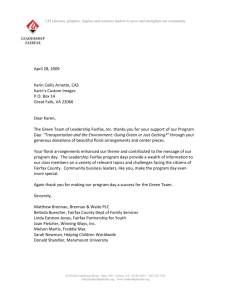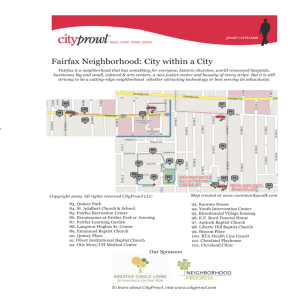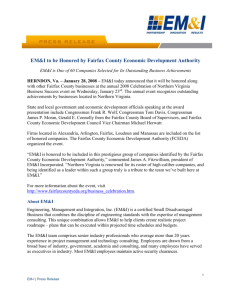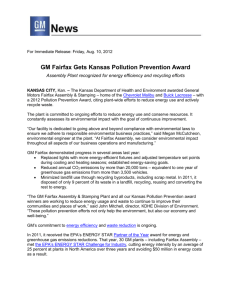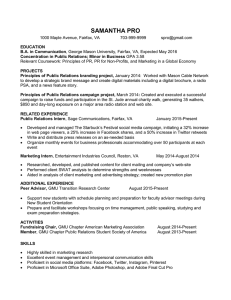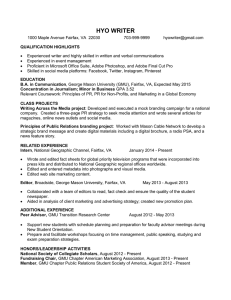Sample Chapter
advertisement
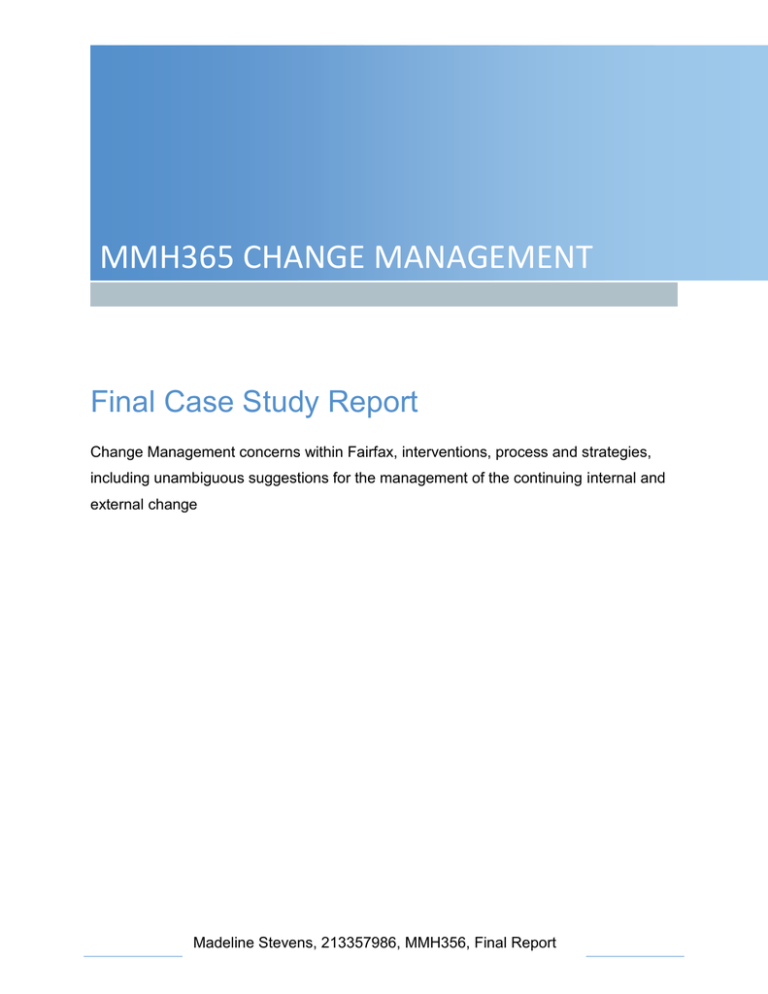
MMH365 CHANGE MANAGEMENT Final Case Study Report Change Management concerns within Fairfax, interventions, process and strategies, including unambiguous suggestions for the management of the continuing internal and external change Madeline Stevens, 213357986, MMH356, Final Report Table of contents TABLE OF CONTENTS II ILLUSTRATIONS III EXECUTIVE SUMMARY 250 IV BACKGROUND 100 1 1. INTRODUCTION 100 2 2. FAIRFAX ORGANISATIONAL CHANGE 3 2.1 Environment 4 2.2 Key Change Issues 5 2.2.1 Cultural Change 6 2.2.2 Structural Change 7 2.3 Strategic Processes 9 2.4 Process Interventions 11 CONCLUSION 100 13 RECOMMENDATIONS 200 14 REFERENCES 15 Madeline Stevens, 213357986, MMH356, Final Report II Illustrations Page Figure 1: Australian Metro Media Financial Snapshot 8 Figure 2: Application strategies for Transorganisational Development 9 Figure 3: Strategic Analysis 2011 10 Figure 4: Communications in Human Resources 12 Madeline Stevens, 213357986, MMH356, Final Report III Executive Summary This report provides an evaluation and analysis of the current management of change within Fairfax Media Limited. Due to the shift in online technology Fairfax have proven that there is a need for constant change management. Within Fairfax there has been not only the management to assist with all types of change but interventions around the cultural and structural issues faced in their over 180 years existence. The approaches of managing change have been developed over some time with the findings of information analysed being seen as the digital industry develops even faster then first anticipated causing printing manufacturers to branch out into alternative options to sustain survival. Finding that the printing industry of Fairfax has had to remodel the entire business that once use to be a standalone corporation, this restructuring has caused some retaliation predominantly within the community directly linked to the diminishing printing production. Reviewing financial reports and analysing some valuable statistics it is apparent the dedication and drive Fairfax have, with the support of employees and stakeholders whom have finally realised this was the only chance at staying afloat. With their strategic acquisition of several newly adopted businesses within the media and advertising they have attempted to redesign their image. Overall there has been a fight within the organisation to hold their position that has now shifted to an online media business. In this report there are clear recommendations and successfully executed strategies within the organisation but they are fully aware of the capability of the unknown and continuously developing online network combined with the driving force of the consumers that is cause forfuture limitations. Madeline Stevens, 213357986, MMH356, Final Report IV Background A more comprehensive understanding of Fairfax Media is essential due to over 180 years existence within the media industry but also their change in ownership and struggles with obstacles like the introduction of mainstream technology and our evolving population.Like most formerly established newspaper printing organisations there has been an ongoing struggle with entering and succeeding in the growing online world. Due to the size of Fairfax the struggle was constantly in the news headlines and stock markets suffered immensely (Jaspan, 2012). Launching from the first Sydney newspaper back in 1953, to the struggles and adaption to the newly styled paper to broaden their reach the struggle within this empire has not been entirely stress-free (Sydney Morning Herald, 2013) yet with all the hurdles faced they have been able to evolve into the media giant they are today (Fairfax Media, 2015). Madeline Stevens, 213357986, MMH356, Final Report 1 1. Introduction This report will be focused on Fairfax Media Limited and the struggle to maintain its presence within the market and what interventions have been implemented to keep not just afloat but continue as a market leader (Fairfax Media, 2015).Within this paper I will provide the key details with the application of three specific interventions applied, and provide a comprehensive analysis using historic information, reports, articles and results based on strategic key change management concepts. This will help to gain a greater understanding of the evolving technology within the media industry and how Fairfax has been able to survive and restructure successfully. Madeline Stevens, 213357986, MMH356, Final Report 2 2. Fairfax Organisational Change Leading Australia and New Zealand in the media industry Fairfax now provides the largest range of diverse divisions referred to as a multi platform media group their market share current price at $0.88 (Invest Smart, 2015) the several branches now being specialised include newspapers, magazines, radio, Domain group and digital media (Fairfax Media Limited SWOT Analysis, 2015, p6). These branches mentioned are only a brief description into the numerous popular and highly recognised online and printed content along with the ongoing attainment of already well-established organizations to add to the plethora of media outlets. When looking at the multitude of what Fairfax now covers it is easy to understand how and why the efficient implementation of change management has been necessary, change itself is expected and regardless if organisations are proactive in business operations it is not a guarantee of success. Caution is needed for balance in the amount of change that is pushed into each project decision and also avoidingthe risk of too little. It can be seen as a waste to plan too far into the future in regards to change anda waste of vital resources, hence the importance around balance. There has been an entire shift in the media industry and the need for change has been recognised and evidently implemented throughout. Change management can be seen as both long-term and short term with the two complimenting each other overall, the purpose of this allows for adjustments and improvements as they are shifted into a more permanent culture and core values. With the focus on change and adaption, there should be extra attention on ensuring any negative repercussions are monitored with the main purpose of the change implementation being positive and proactive. There are so many levels and sub levels when dissecting the actual functioning process of change, sometimes focusing on the weaknesses are not the most productive but the opportunities and strengths that directly link help maintain the competitive edge (Fairfax Media Limited 2015). Madeline Stevens, 213357986, MMH356, Final Report 3 2.1 Environment The general environment is viewed as everything outside of the organisation yet has direct influence on the whole operational component; there are three specific environments, which can be either direct or indirect. Due to the open system within organisations there must be a relationship with their environments if functionality and success is desired. Organisations can also directly or indirectly impact the environment, which is where laws and regulations must be followed and promoted within the business to create a positive and favorable brand (Waddell et al. 2014 p.261-273). The overall environment directly linked to Fairfax includes technological, social, political, and economical. The technological dimensions would be viewed as the most important direct element (Porter, M 1985) within the media industry having to adapt and evolve from the declining paper hard copy (Christensen, N, 2014) to not only online but creating a diverse branch of alternative services to offer to the audience to keep up within the media market’s shift towards digital interaction. The internal environment must process information in order to better understand the current environment, this has been found to be slightly ambiguous but no matter how much you try to reduce this there will always be some kind of uncertainty (Waddell et al. 2014 p.262-283). The never ending needs and consumersatisfaction is a key task environment, by developingthis core objective it could possibly be the most significant environmental influence. Internally with the driving force being competition Fairfax have product innovation and expansion, which is done to keep afloat, if not to keep ahead of competition which are all apart of the external task environment. The direct relationships whether through, customers, suppliers, competitors, financial institutes, are all mutually influencing on each other, which can be taken advantage of if managed properly (Waddell et al. 2014 p.262-264). Madeline Stevens, 213357986, MMH356, Final Report 4 With all of the above-mentioned in mind Fairfax has a solid brand and market imprint contributing to its enacted environment, which is why the organisation is still standing steadily with two feet. Through all of its struggles and victories there is a strong environmental culture where we see risks taken and new ideas constantly emerging, which drives everyone involved to continue building and remodeling the facade of this empire. With such a forward foot to survive in the future, which is evident with simulations applied like the Monte Carlo sensitivity analysis to test the growth rates finding out the strength of their models (Sydney Investment Group, 2011). 2.2 Key Change issues Fairfax can be viewed as a leader in change within the corporate organisation community, with some of the changes either internally and not viewed by the external buyers or sometimes not as successful or implemented as originally planned.No matter how successful the outcome,what this does show is Fairfax are willing to fight for their position within the market and overall there has been a stable position held due to the awareness of their key change issues (The Financial Times LTD, 2015). There are three key interventions, which have been how the organisation has developed through numerous interrelated issues all based around diversity, interaction of human behavior and technology. With a key focus on both structural and operational changes incorporating the interventions Fairfax have claimed to be well ahead of their plans to being a modern media company (CEO Speech). However, Fairfax’s previous and ongoing changes still require extensive monitoring and refining which ensures they will bemuch more confident inthe ability to work through any future issues that may arise and how they have adapted and grown with the additional industries added to the organisation. It is important to keep an open mind and look at the Macroeconomical position with the Madeline Stevens, 213357986, MMH356, Final Report 5 introduction of the online world wide when looking at the key change issues presented in Fairfax. As impacting e-commerce has been on the industry this scenario has impacted the entire world causing a shift in the way businesses need to function. With incorrect management guiding the journalistic based company it actually hasn’t steered too far from the style and underlying tasks being completed. The decline cannot be focused based on only the technological world, but the shift in wants, needs and desires along with the core subscribers including more females and change in interests. These types of assumptions are not always entirely true nor do they predict the change I direction would actually benefit the papers subscribers, on the other end of the spectrum there are the loyal readers who no long find the paper informative or struggle to read its more modern layout and smaller print.The actual driving revenue was the advertisements placed, and the management behind all significant decisions have been criticized for blaming it all on the shift to online rather then the possibility of just bad management (Green, 2012). 2.2.1 Cultural Changes Culture tends to be overlooked as a highly strategic method to implement change indirectly forcing greater effectiveness, with values and assumptions to be incorporated allows for less liability when implementing changes in such turbulent environment as Fairfax. The correct and satisfactory management of culture would see a higher team or group participation rate along with open communication, security and equality, all of these additional aspects although not always a clear representation of how an organisation is functioning the change in culture is recommended to be observed strategically (Waddell et al. 2014 p.322-332). Downsizing of the organisation (Appelbaum, Everard, Hung, 1999) is attempted strategically to maintain a presence and avoid complete extinction but the goal to ultimately redeploy as many multi skilled employees within new and merged rolls throughout the entire organisation (Hurst, 2012). When applied correctly it can improve the fit between individual abilities and the demands of the shifting jobs. When it was announced in 2013 that the plan was for a 3-year implementation of one-fifth of Fairfax’s Madeline Stevens, 213357986, MMH356, Final Report 6 workforce to suffer job cuts it was hard to see past the employee’s potential loss of jobs, when regrettably it was the only way the struggling printing division of the organisation was to survive (The Australian, 2013). Within the internal environment there are struggles like job security and resistance to change which are tackled by working with the employees and promoting realistic expectations and support incorporating programs like health promotion and career planning also create a positive and safe environment when there is such uncertainty around (Waddell et al, 2014, p.157-161). The key focus within the working culture is equality (Hywood, 2015), which is clearly displayed by each division leading the industry with awards and recognition (Fairfax Media, 2015). The internal and external drivers of implementing an innovative and diverse culture creates a multidimensional and productive environment, these are forces that drive change within all levels of the organisation (Kennedy &McComb, 2014). The SWOT analysis has helped assess and minimise any impacting influences (Fairfax Media Limited SWOT Analysis, 2015, p4). The organisational development interventions used are practical and achievable models that are designed to solve goals or improve productivity, which creates a positive and motivated working environment. 2.2.2 Structural Changes The restructuring of the business (Zappone, 2008) gives structural direction as it evolves and recreates itself, which allows for the organisation as a whole to develop and hold a presence within the previously dying print industry in the new online era (Hatch, 2013). The social and technological systems within an organisation should both be supported when looking at the organisational design not only to address problems but also to create alternative results (Waddell et al, 2014, p.150-155). The organisational system of the technical model is always a risk resulting in some barriers to job enrichment, the limits of technology can cause an enrichment ceiling with barriers of the overall process and procedures. Madeline Stevens, 213357986, MMH356, Final Report 7 The better the knowledge of the over all environment the more understanding we have on our audience, although Fairfax wouldn’t have originally been considered to be dynamic and unpredictable the external factors have causedso much uncertainty resulting in the whole industry needing tobe restructure. Fairfax’s entered the media industry formerly with their infamous news papers and that particular section of the business has now faced all kinds of restructuring to gain efficiency and maintain their position within the printing market, it is only with the internal environmental changes and the success of implementing online alternatives has there managed to be a profit within this section. Figure 1: Australian Metro Media Financial Snapshot (Source: Fairfax Media Annual Report, 2015) Although outside of our control the general external environment can have a direct influence on the whole operational component, the technological dimensions would be undoubtedly the most important element (Porter, M 1985). Fairfax is constantly in the Madeline Stevens, 213357986, MMH356, Final Report 8 news headlines for the reshuffles and changes promising it will drive revenues and efficiency. Implementing these types of changes Fairfax need to ensure they are the correct changes to the business processes, Fairfax is a tall hierarchy structure and is slowly transitioning over to a more flat organisational structure which will help management and employee relationships internally (CEO Speech, 2013, p.5). Another way Fairfax is working with external environments is to actually improve the operations are drivers like the Fairfax Mobile Network Survey conducted in November 2014, this report providedessential insightsinto their users which would assist with improvement and restructuring if deemed necessary (Fairfax Mobile Network, 2015). 2.3 Strategic processes By transforming to an online presence (NewsHound report, 2005) and keeping up to date with new trends and technology within the media industry helped assist with maintaining a competitive edge in the rapidly changing conditions (Porter, M 1985). This strategic process was Fairfax’s way of adapting to the online culture, which added multiple branches to their business expending the overall reach and brand. This also enabled an extended audience reach along with the ability to amalgamate some employee roles together.Transorganisational development has been applied to collaborate the now multi-organisation, this creates a stronger relationship and competitive strategies resulting in improved services and a stronger economic position (Waddell et al. 2014). Figure 2: Application strategies for transorganisational development Madeline Stevens, 213357986, MMH356, Final Report 9 (Source: Waddell et al. 2014 p.271) The results found in the “CFA Institute Research Challenge” provided a deeper insight, which showed one specific reoccurring piece of evidence, and that was the importance and impact online technology has affected, and will continue to guide the entire industry(Sydney Investment Group, 2011). Figure 3: Strategic Analysis (Source: Sydney Investment Group, 2011) In conjunction with time quality management (TQM) and a strategic analysis implemented internally we would see the internal driving force improved as it seeks efficiency and productivity within the organisation (Douglas, 2013), meaning the way executives respond to the improved environment. A perfect example of strategic implementation within Fairfax is the new acquisition of Property Data Solutions (PDS), a property data and mapping provider shows the ability and intellect behind strengthening the brand creating prospects as a tactical investment, which provides product offerings and variety in its income base (Fairfax Media Limited, 2015). Madeline Stevens, 213357986, MMH356, Final Report 10 2.4 Process interventions The actual process of the interventions must be noted as an important part of the whole method used, as it is the employees tool for achieving the organisational goals (Tearle, 2011). The key interventions for Fairfax that are utilized differently throughout are, performance management, appraisals, reward system and goal setting. All of the interventions mentioned above are built into the Fairfax program but as most other organisations this must be closely watched and altered if required (Ads Centre, 2015). The effective management of people can also be referred to as performance management, this is the actual management of the performance of the workforce in an organisation. This particular type of management can be the teams performance or individual and is very dependent on individual factors, with alignment as one of the key component when looking at successful performance management systems. There should be a clear and defined link between the organisational goals and objectives and the management of performance, which must also align itself with the appraisals conducted. A top down approach is being moved away from and there is a push towards a multichannel communications process. The issues of underperformance should also be mentioned as a usually overlooked issue, this should be solved with an internal systematic approach to address the matter (Ashdown, 2014). Figure 4: Communications in Human Resources (Source: Performance Management, 2007 p.80) Madeline Stevens, 213357986, MMH356, Final Report 11 In implementing performance management and appraisals to educate the employees it always needs to be followed by evaluation and rewards, this compliments the process as a whole and provides guidance and incentives to maintain this level of standard. The biggest issues faced are conflict and encouraged competition, which in return causes a negative working environment (Roth, WF 2014). The reward system itself can be either intrinsic or extrinsic, where intrinsic are internal forces driven from challenge, improvement and accomplishment opportunities found in the workplace. Extrinsic is the various kinds of monitory based rewards but the behaviors behind the drive of these should be regularly reinvented to keep the workers interested (Waddell et al. 2014 p.174-177). It is the role of the human recourses and management to try and combine the two within the personal and group satisfaction. This model is the root to the reward theory and must always be observed, as there has been studies presenting undesirable relations between the two and its relation with motivation and performance(Harackiewicz&Sansone, 2000 p14-18). Madeline Stevens, 213357986, MMH356, Final Report 12 Conclusion Throughout Fairfax’s history there have been many struggles within the changing environments implemented through the whole organisation that has proven to maintain the consumers satisfaction. This being the core objective and possibly the most significant environmental influence the task environment is one of the key management concepts as the driver of the organisation. Although technology is a major component and should not be overlooked the cultural influence would almost outweigh the importance of controlling the decision-making and further understanding within the unstable environment. Fairfax has all the right intentions in managing the change environments, although successful in implementing these initiatives there is still a large amount of unknown, which is driven by external forces. With the brand holding such a strong position it would be impetrative that the correct steps are continued to be taken for enduring success. Madeline Stevens, 213357986, MMH356, Final Report 13 Recommendations It is evident that the change management strategies employed by Fairfax have displayed to be proactive and allowed them to be a key player within the multidimensional media industry; they have restructured and expanded exploiting their stronger abilities to maintain the market leader. Based on the research and critical analysis of information the following recommendations are made: External environment has been the greatest battle for Fairfax and the early detection and proactive battle is the reason why the business still stands, this strategy should continue to ensure it is ready for any change from external sources that directly link back. Internally there needs to be a greater implementation of understanding and management due to the uncertainty around the restructuring and closure of so many of their printing branches, with a focus on redeployment and role restructuring. The trans-organisation system should be religiously tracked and applied to assist with the cost and benefit challenge faced, and also to create a stronger brand and image within the Fairfax community. The process interventionsmotioned within this reportcreate value and a unique realignment of the employees and organisational goals and objectives, by creating a culture where employees feel support motivation is achieved. Madeline Stevens, 213357986, MMH356, Final Report 14 References Ads Centre 2015, Awards and Recognition, Fairfax Media, retrieved 17 September 2015, <www.adcentre.com.au/about/awards-recognition/>. Appelbaum, SH, Everard, A. & Hung, L.T.S 1999, "Strategic downsizing: critical success factors", Management Decision, vol. 37, no. 7, pp. 535-552. Ashdown, L 2014, Performance management, London, Kogan, retrieved 20 September 2015. Barnett, S, Townend, J 2015, ‘Media Power and Plurality: From Hyperlocal to HighLevel Policy’, pp.117-119. Christensen, N 2014, ABCs: Double digit declines for newspapers, Mumbrella, retrieved 16 September 2015,<http://www.abc.net.au/mediawatch/transcripts/1403_mumbrella.pdf>. Cummins, C, 2015, Fairfax Media sells print plants for $61 million, Sydney Morning Herald, retrieved 17 September 2015, <www.smh.com.au/business/property/fairfaxmedia-sells-print-plants-for-61-million-20150807-gitud6.html>. Douglas, A 2013, The International Review Of Organizational Improvement, The TQM Journal, retrieved 18 September 2015, EBSCOhost. Fairfax Media 2015, Corporate Profile, Fairfax Media, retrieved 18 September 2015, <www.fairfaxmedia.com.au/Company/Corporate-Profile/corporate-profile>. Fairfax Media 2015, Corporate Profile, Fairfax Media, retrieved17 September 2015, <www.fairfaxmedia.com.au/Company/Corporate-Profile/corporate-profile>. Fairfax Media Annual Report, 2015, Annual Report, Grow Transform Invest, retrieved 18 September 2015, <http://issuu.com/fairfaxmediabrand/>. Fairfax Media Limited 2015, ‘Fairfax Media Limited SWOT Analysis’, Mar2015, pp. 1-8, retrieved16 September 2015, Business Source Complete. Fairfax Mobile Network, 2015, Fairfax Media Smartphone News Consumption Audience Study,retrieved 16 September 2015,<https://www.iabaustralia.com.au/uploads/uploads/201503/1426003200_6bc82c676df45d506dfb0a1d45374104.pdf>. Madeline Stevens, 213357986, MMH356, Final Report 15 Green, J 2012, The Drum, Don’t just blame the web for Fairfax’s failure, retrieved 17 September 2015, <www.abc.net.au/news/2012-06-18/green-fairfax-woes-longpreceded-the-internet/4077292>. Harackiewicz, J,Sansone, C 2000, Intrinsic And Extrinsic Motivation : The Search For Optimal Motivation And Performance, vol. 1. Hatch, B 2013, CHANGES TO ORGANISATIONAL STRUCTURE AND EXECUTIVE LEADERSHIP TEAM, Fairfax Media, 15 September 2015, <www.fairfaxmedia.com.au/pressroom/au---nz-press-room/au---nz-pressroom/changes-to-organisational-structure-and-executive-leadership-team>. Hatch, B 2013, CHIEF EXECUTIVE OFFICER’S SPEECH, ANNUAL GENERAL MEETING, Fairfax, Sydney, pp. 1 – 7. Hirst, M 2012, Fairfax’s strategy for ‘structural change’ does little to shake that sinking feeling, The Conversation, retrieved 18 September 2015, <http://theconversation.com/fairfaxs-strategy-for-structural-change-does-little-to-shakethat-sinking-feeling-10298>. Hywood, G 2015, Pressroom, Fairfax Media, retrieved18 September 2015, <www.fairfaxmedia.com.au/pressroom>. Jaspan, A 2012, Fairfax Media: how for want of a digital vision, the ship was lost, The Guardian, retrieved 14 September, <http://www.theguardian.com/media/2012/jun/18/fairfax-media-australia>. Kennedy, DM, &McComb, SA 2014, 'When teams shift among processes: Insights from simulation and optimization', Journal of Applied Psychology, vol. 99, no. 5, pp. 793-796 Available from: 10.1037/a0037339, retrieved 16 September 2015. NewsHound report 2005, In the internet Age, The Age, retrieved 18 September 2015, <http://www.theage.com.au/news/creative--media/in-the-internetage/2005/10/21/1129775943039.html>. Performance management [electronic resource] 2007, London Teachers TV/UK Department of Education,pp. 79-81. Porter, M 1985, ‘Competitive Advantage: Creating and Sustaining Superior Performance’, pp.4-7, Simon & Schuster Ltd. Roth, WF 2014, 'Evaluation and Reward Systems: The Key Shapers of Organization Culture', Performance Improvement, vol. 53, no. 8, pp. 24-29. Sinclair, L, Bodey, M 2013, The Australian 2015, Fairfax Media in another major reshuffle, retrieved 19 September 2015, Madeline Stevens, 213357986, MMH356, Final Report 16 <http://www.theaustralian.com.au/business/media/fairfax-media-in-another-majorreshuffle/story-e6frg996-1226612249177>. Sydney Investment Group 2011, Fairfax Media Limited (FXJ.AX), Publishing and Online Media, Viewed 18th Sep 2015. Sydney Morning Herald, 2013, retrieved 14 September 2015. <https://web.archive.org/web/20130410020444/http://www.heraldeducation.com.au/cont ent/history/gjful4>. Tearle, R 2011, Organisational Development Interventions, Change Designs, retrieved 16 September 2015, <www.changedesigns.net/public/team/team_strategy/Teamintervention.html>. Tearle, R 2011, Organisational Development Interventions, Change Designs, retrieved18 September 2015, <www.changedesigns.net/public/team/team_strategy/Team-intervention.html>. The Financial Times 2015, Fairfax Media Ltd, retrieved, Thomson Reuters, 18 September, <http://markets.ft.com/research/Markets/Tearsheets/Forecasts>. Waddell,D, Creed, A, Cummings, T, Worley, C 2011, Organisational change development and transformation, 5th edition , Cengage Learning, Melbourne. Zappone, C 2008, Fairfax Media to cut 550 jobs, The Sydney Morning Herald, 18 September 2015, <http://www.smh.com.au/business/fairfax-media-to-cut-550-jobs20080825-42fu.html>. Madeline Stevens, 213357986, MMH356, Final Report 17
